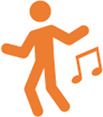Table 1.
Reducing sedentary behavior by WHO guidelines.
| Activity | Description | Action | |
|---|---|---|---|

|
Take short active breaks during the day | Short bouts of physical activity add up to the weekly recommendations; | Dancing, playing with children, and performing domestic chores (i.e.: cleaning and gardening) and other means to stay active at home. |

|
Follow an online exercise class | Take advantage of the wealth of online exercise classes; | Many of these are free and can be found on YouTube. If you have no experience performing these exercises, be cautious and aware of your own limitations. |

|
Walk | Walking around or walking on the spot, can help you remain active; | If you have a call, stand, or walk around your home while you speak, instead of sitting down. |

|
Stand up | Interrupt sitting and reclining time every 30 min; | Reduce your sedentary time by standing up whenever possible. During sedentary leisure time prioritize cognitively stimulating activities (i.e.: reading, board games, and puzzles). |

|
Relax | Meditation and deep breaths can help you remain calm; | Sit comfortably or legs up the wall. Concentrate on your breath, trying not to focus on any thoughts or concerns. Stay comfortable, relaxing and de-stressing. |

|
Eat healthily and stay hydrated | Ensure plenty of fruits and vegetables, and limit the intake of salt, sugar and fat. Limit or avoid alcoholic drinks; | Plan your intake. Use fresh ingredients. Be aware of portion sizes. Avoid drinking caffeinated and energy drinks. Drinking water instead of sugar-sweetened beverages. |
